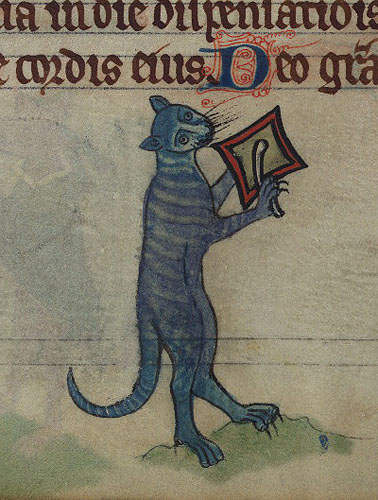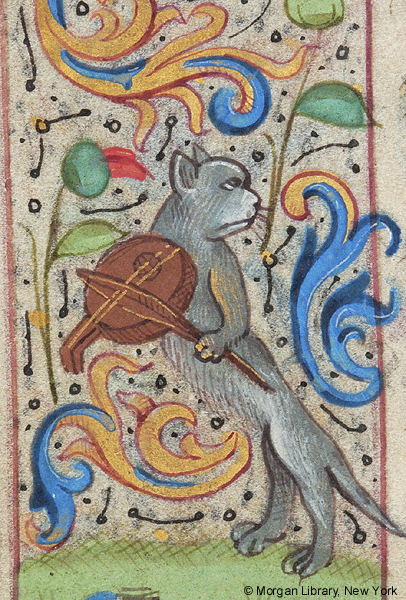

NB: This satirical post was shared in celebration of April Fool’s Day 2022.
Many here in New Jersey are admirers of Nora, the Piano Playing Cat, the Camden kitty who since 2007 has wowed music lovers worldwide with her talent at the keyboard. Her fame even inspired the Lithuanian conductor Mindaugas M. Piečaitis to compose her a “Catcerto.” If you haven’t ever heard this piece, by the way, it’s well worth a listen.
But are musical moggies really a modern phenomenon? Evidence unearthed by researchers at Princeton University’s Index of Medieval Art suggests otherwise. Manuscript illuminations from late medieval Europe clearly depict cats performing on a variety of musical instruments, from the organ and tabor to the vielle and more. Here we present a preview of findings from this pathbreaking research project, soon to appear as an article in the interdisciplinary medieval studies journal Scientia de animalibus.

Musical training of felines often began at the keyboard, allowing teachers to capitalize on cats’ natural impulse to bat at a target with their paws. Meticulous application of a featherstick to each key to be struck, along with the copious provision of treats, encouraged both musical precision and a vigorous technique on both portative and positive organs.

Further mastery of percussion came with training in the tabor, a small hand- (or paw-) held drum that is played with a stick. A small strap was used to affix the drum to the cat’s left paw while it impaled the stick with its claws. Although this technique must have been difficult to learn, the surviving images suggest that some cats mastered it so well that they could stand on their hind legs while playing.

Those cats with sufficient coordination and ambition could next be moved on to bowed instruments like the vielle, shown here. In addition to requiring vertical balance, this instrument demanded both toe dexterity and a highly refined ear, the latter fortunately not a problem for these aurally acute ailurids.

Only those cats with the highest musical ability could advance to learning the bagpipes because of the precision needed to coordinate breathing, elbow pressure, and the placement of toe pads. Among the few feline masters of this instrument was a white monastic cat named Pangur Bán, whose signature “Katzenellenbogen” performance technique is still used by pipers today. Pangur was a true polymath who was also commemorated in verse for his “joyous with speedy going” after mice in his home abbey near Reichenau. Index researchers believe that the image above may portray Pangur himself, based on his obvious mastery of tongue and paw position.
We at the Index hope that you’ve enjoyed this foray into our research on medieval feline musicians, who set the stage for Nora and the rest of today’s musical cat performers while also launching your April Fool’s Day 2022 on a truly harmonious note.